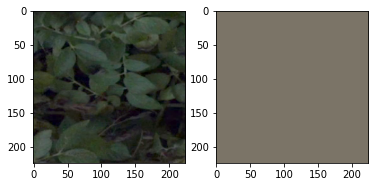I have created a conv autoencoder to generate custom images (Generated features can be used for clustering). But I am not able to generate the images, even the result is very bad. I am not able to understand what is this problem. Image size is 240x270 and is resized to 224x224
Autoencoder class is as follow
self.encoder = nn.Sequential(
nn.Conv2d(3, 16, 7, stride=3, padding=1), # b, 16, 10, 10
nn.ReLU(True),
nn.Conv2d(16, 32, 7, stride=3, padding=1), # b, 16, 10, 10
nn.ReLU(True),
nn.Conv2d(32, 64, 3, stride=2, padding=1), # b, 16, 10, 10
nn.ReLU(True),
nn.Conv2d(64, 128, 3, stride=2, padding=1) # b, 16, 10, 10
# nn.ReLU(True),
# nn.Conv2d(128, 256, 2, stride=5, padding=1) # b, 16, 10, 10
)
self.decoder = nn.Sequential(
# nn.ConvTranspose2d(256, 128, 2), # b, 16, 5, 5
# nn.ReLU(True),
nn.ConvTranspose2d(128, 64, 3,stride=2, padding=1), # b, 16, 5, 5
nn.ReLU(True),
nn.ConvTranspose2d(64, 32, 3,stride=2, padding=0), # b, 16, 5, 5
nn.ReLU(True),
nn.ConvTranspose2d(32, 16, 5, stride=3, padding=0), # b, 8, 15, 15
nn.ReLU(True),
nn.ConvTranspose2d(16, 8, 7, stride=3, padding=0,output_padding=1), # b, 1, 28, 28
nn.ReLU(True),
nn.ConvTranspose2d(8,3, 7, stride=1, padding=0), # b, 1, 28, 28
nn.Sigmoid()
)
def forward(self, x):
x = self.encoder(x)
x = self.decoder(x)
return x
Model Summary is as follow
----------------------------------------------------------------
Layer (type) Output Shape Param #
================================================================
Conv2d-1 [-1, 16, 74, 74] 2,368
ReLU-2 [-1, 16, 74, 74] 0
Conv2d-3 [-1, 32, 24, 24] 25,120
ReLU-4 [-1, 32, 24, 24] 0
Conv2d-5 [-1, 64, 12, 12] 18,496
ReLU-6 [-1, 64, 12, 12] 0
Conv2d-7 [-1, 128, 6, 6] 73,856
ConvTranspose2d-8 [-1, 64, 11, 11] 73,792
ReLU-9 [-1, 64, 11, 11] 0
ConvTranspose2d-10 [-1, 32, 23, 23] 18,464
ReLU-11 [-1, 32, 23, 23] 0
ConvTranspose2d-12 [-1, 16, 71, 71] 12,816
ReLU-13 [-1, 16, 71, 71] 0
ConvTranspose2d-14 [-1, 8, 218, 218] 6,280
ReLU-15 [-1, 8, 218, 218] 0
ConvTranspose2d-16 [-1, 3, 224, 224] 1,179
Sigmoid-17 [-1, 3, 224, 224] 0
================================================================
Total params: 232,371
Trainable params: 232,371
Non-trainable params: 0
----------------------------------------------------------------
Input size (MB): 0.57
Forward/backward pass size (MB): 11.50
Params size (MB): 0.89
Estimated Total Size (MB): 12.96
----------------------------------------------------------------
Data Loader class is as follow
mean = torch.tensor((0.485, 0.456, 0.406)).reshape(1,3,1,1).cuda().requires_grad_(False)
std = torch.tensor((0.229, 0.224, 0.225)).reshape(1,3,1,1).cuda().requires_grad_(False)
def normalize(tensorInput, mean=mean, std=std, device=None):
return tensorInput.sub(mean.to(device)).div(std.to(device))
def denormalize(tensorInput, mean=mean, std=std, device=None):
return tensorInput.mul(std.to(device)).add(mean.to(device))
class DatasetLoader(torch.utils.data.Dataset):
def __init__(self, root, transforms=None):
self.root = root
self.transforms = transforms
self.imgs = list(sorted(os.listdir(root)))
def __getitem__(self, idx):
img_path = os.path.join(self.root, self.imgs[idx])
img=cv2.imread(img_path)
img=cv2.cvtColor(img,cv2.COLOR_BGR2RGB)
img = cv2.resize(img,(32,32)) / 255.0
img = np.transpose(img,[2,0,1]).astype(np.float32)
return torch.from_numpy(img)
def __len__(self):
return len(self.imgs)
Dataloading and train script is as follow
dataset = DatasetLoader('D:\images\Bright_240_270', get_transform(train=True))
torch.manual_seed(1)
indices = torch.randperm(len(dataset)).tolist()
dataset = torch.utils.data.Subset(dataset, indices[:-50])
dataset_test = torch.utils.data.Subset(dataset, indices[-50:])
data_loader = torch.utils.data.DataLoader(
dataset, batch_size=batchSize, shuffle=True, num_workers=0)
data_loader_test = torch.utils.data.DataLoader(
dataset_test, batch_size=1, shuffle=False, num_workers=0)
device = torch.device("cuda" if torch.cuda.is_available() else "cpu")
model = autoencoder().to(device)
summary(model, (3, 224, 224))
criterion = nn.MSELoss()
# criterion = nn.BCELoss()
optimizer = torch.optim.Adam(model.parameters(), lr=learning_rate,weight_decay=1e-5)
trainLoss=[]
total_loss = 0
data_iter = 0
for epoch in range(num_epochs):
data_iter = 0
for data in data_loader:
# print(data)
img = data.clone().detach().cuda()
# print("Min Value of input Image = ",torch.min(img))
# print("Max Value of input Image = ",torch.max(img))
img = Variable(img).cuda()
img= normalize(img)
# ===================forward=====================
output = model(img)
print(data.min(),data.max(),output.min().item(),output.max().item())
output = denormalize(output)
# print("Input Image shape = ",img.shape)
# print("Output Image shape = ",output.shape)
loss = criterion(output,data.cuda())
show_and_save_figure(data[0],output[0],'AutoEncoder')
# ===================backward====================
optimizer.zero_grad()
loss.backward()
optimizer.step()
data_iter=data_iter+1
if data_iter % 10 == 0:
print(f"Data Iteration = {data_iter}")
total_loss += loss.data
# ===================log========================
total_loss /= len(data_loader)
trainLoss.append(trainLoss.append(loss.data.cpu().detach().numpy()))
plt.plot(trainLoss)
plt.xlabel('Epochs')
# naming the y axis
plt.ylabel('Loss')
# giving a title to my graph
plt.title('Training loss')
plt.show()
print('epoch [{}/{}], loss:{:.4f}'
.format(epoch+1, num_epochs, total_loss))
The original image and image generated are

Where is the problem. Why I am not able to generate it?